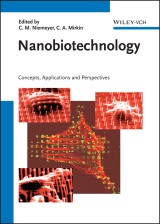Details

Nanobiotechnology
Concepts, Applications and Perspectives1. Aufl.
|
228,99 € |
|
| Verlag: | Wiley-VCH (D) |
| Format: | |
| Veröffentl.: | 06.03.2006 |
| ISBN/EAN: | 9783527605910 |
| Sprache: | englisch |
| Anzahl Seiten: | 491 |
DRM-geschütztes eBook, Sie benötigen z.B. Adobe Digital Editions und eine Adobe ID zum Lesen.
Beschreibungen
Nanotechnology is the key technology of the 21st century. The possibility to exploit the structures and processes of biomolecules for novel functional materials, biosensors, bioelectronics and medical applications has created the rapidly growing field of nanobiotechnology.<br> Designed as a broad survey of the field, this book combines contributions from bioorganic and bioinorganic chemistry, molecular biology, materials science and bioanalytics to fathom the full scope of current and future developments.<br> It is divided into four main sections: <br> * Interphase Systems<br> * Protein-based Nanostructures<br> * DNA-based Nanostructures<br> * Nanoanalytics<br> Each chapter describes in detail currently available methods and contains numerous references to the primary literature, making this the perfect "field guide" for chemists, biologists and materials scientists who want to explore the fascinating world of nanobiotechnology.<br>
I INTERPHASE SYSTEMS<br> Biocompatible inorganic devices<br> Microfluidic "Lab-on-a-chip" devices<br> Microcontact printing of proteins<br> Cell-nanostructure interactions<br> Networks of neuronal cells on silicon substrates<br> II PROTEIN-BASED NANOSTRUCTURES<br> S-Layers<br> Engineered nanopores<br> Genetic appoaches to particle assembly<br> Microbial nanoparticle production<br> Magnetosomes<br> Bacteriorhodopsin technology<br> Polymer nanocontainers<br> Protein biomolecular motors<br> Nanoparticle-biomaterial hybrid systems<br> III DNA-BASED NANOSTRUCTURES<br> DNA-protein nanostructures<br> DNA-templated electronics<br> DNA-based metallic nanowires<br> Mineralization in nanostructured biocompartments<br> DNA-gold-nanoparticle conjugates<br> DNA nanostructures for mechanics and computing<br> Nanoparticles as non-viral transfection agents<br> IV NANOANALYTICS<br> Quantum dot biolabeling<br> Nanoparticle molecular labels<br> Analysis of biomolecular structure by AFM and molecular pulling<br> Force spectroscopy<br> Biofunctionalized nanoparticles for SERS and SPR<br> Bioconjucated silica particles in bioanalysis<br>
"For those wanting to know more about this emerging scientific area, this is an excellent starting point."<br> Microbiology Today<br> <br> "....describes in detail all currently available methods of this novel field of research...a perfect guide for chemists, biologists, and material scientists who want to explore the fascinating world of nanobiotechnology."<br> Polymer News<br> <br> "In summary, I would rate the book a >strong buy<. It is a high-quality text - well illustrated, and extensively referenced - that provides the first authoriative overview of this emerging field."<br> SPIE Nanotechnology E-Bulletin <br> <br> "This book really does represent a fine collection of chapters by respected authors describing current thinking on this subject. The book represents a substantial and realistic compendium of the key concepts and realities of modern nanobiotechnology and should be on the purchaselist of all biologists, chemists, physicists and engineers wishing to acquaint or immerse themselves in this newley emerging technology."<br> ChemBioChem<br> <br> "I truly believe that this book can serve as a textbook for graduate students, as an essential reference for active specialists, and as interesting reading material for general readers with a curiosity in bionanotechnology."<br> small<br>
Christof M. Niemeyer is Professor of Chemistry at the University of Dortmund (Germany) where he holds the chair of Biological and Chemical Microstructuring. He was born in Cloppenburg and studied chemistry at the University of Marburg. He did his thesis at the Max-Planck-Institut fur Kohlenforschung in Mulheim/Ruhr under the supervision of Manfred T. Reetz and his postdoctorate with Charles R. Cantor at the Center for Advanced Biotechnology in Boston (USA). He then went back to Germany, where he worked with Dietmar Blohm at the University of Bremen to complete his habilitation before moving to Dortmund as a full Professor in 2002. He is interested in semisynthetic DNA-protein and -nanoparticle conjugates and their applications in life-sciences, catalysis and molecular nanotechnology.<br> ******<br> Chad A. Mirkin is the George B. Rathmann Professor of Chemistry and the Director of the Institute for Nanotechnology and the Center for Nanofabrication and Molecular Self-Assembly at Northwestern University in Evanston.<br> Professor Mirkin holds a B.S. degree from Dickinson College (1986) and a Ph.D. degree in chemistry from The Pennsylvania State University (1989). He was a NSF Postdoctoral Fellow at the Massachusetts Institute of Technology before becoming a chemistry professor at Northwestern University in 1991.<br> Professor Mirkin is known for his development of nanoparticle-based biodetection schemes and his invention of Dip-Pen Nanolithography. He is the founder of two companies, Nanosphere and NanoInk, which are commercializing nanotechnology applications in the life science and semiconductor industries.<br> Professor Mirkin has been recognized for his accomplishments with the 2004 Nobel Laureate Signature Award for Graduate Education in Chemistry (2003), the 2003 Raymond and Beverly Sackler Prize in the Physical Sciences, the 2002 Feynman Prize in Nanotechnology, the 2001 Leo Hendrick Baekeland Award, the Discover 2000 Award for Technological Innovation, I-Street Magazine's Top 5 List for Leading Academics in Technology, the Materials Research Society Young Investigator Award (2000), the ACS Award in Pure Chemistry (1999), the PLU Fresenius Award (1998), the Harvard University E. Bright Wilson Prize (1998), and the BF Goodrich Collegiate Inventors Award (1997).<br>
Nanotechnology is the key technology of the 21st century. The possibility to exploit the structures and processes of biomolecules for novel functional materials, biosensors, bioelectronics and medical applications has created the rapidly growing field of nanobiotechnology.<br> Designed as a broad survey of the field, this book combines contributions from bioorganic and bioinorganic chemistry, molecular biology, materials science and bioanalytics to fathom the full scope of current and future developments.<br> It is divided into four main sections: <br> * Interphase Systems<br> * Protein-based Nanostructures<br> * DNA-based Nanostructures<br> * Nanoanalytics<br> Each chapter describes in detail currently available methods and contains numerous references to the primary literature, making this the perfect "field guide" for chemists, biologists and materials scientists who want to explore the fascinating world of nanobiotechnology.<br>
Diese Produkte könnten Sie auch interessieren:

Systems Biology in Practice

von: Edda Klipp, Ralf Herwig, Axel Kowald, Christoph Wierling, Hans Lehrach

117,99 €















